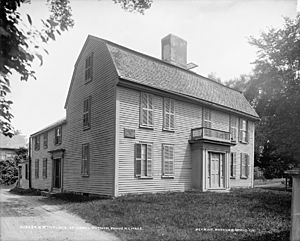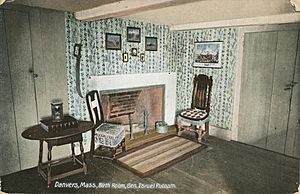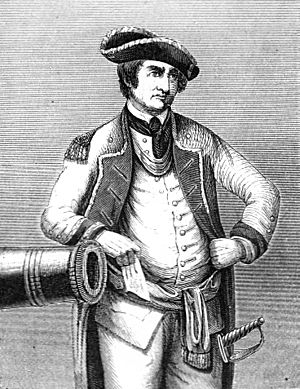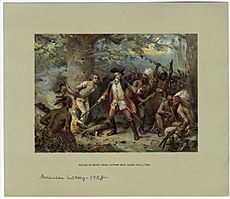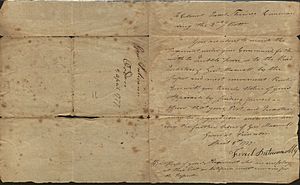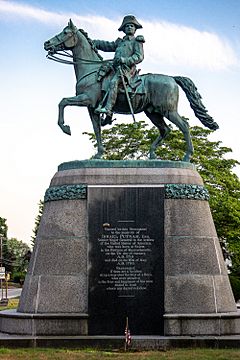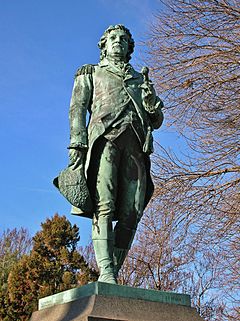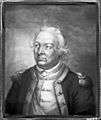Israel Putnam facts for kids
Quick facts for kids
Israel Putnam
|
|
|---|---|

Major General Israel Putnam
|
|
| Nickname(s) | "Old Put" |
| Born | January 7, 1718 Danvers, Province of Massachusetts Bay, British America |
| Died | May 29, 1790 (aged 72) Brooklyn, Connecticut, United States |
| Buried |
Israel Putnam Monument, Brooklyn, Connecticut, U.S.
(41°47′11″N 71°56′59″W / 41.78639°N 71.94972°W) |
| Allegiance | |
| Service/ |
|
| Years of service | 1755–1779 |
| Rank | Major (G.B.) Major general (U.S.) |
| Battles/wars | French and Indian War Pontiac's War American Revolutionary War |
| Spouse(s) |
Hannah Pope
(m. 1739; died 1765)Deborah Lothrop
(m. 1767) |
| Signature | |
Israel Putnam (born January 7, 1718 – died May 29, 1790) was an important American military leader. People often called him "Old Put." He was a brave officer during the American Revolutionary War (1775–1783), especially at the Battle of Bunker Hill. Before that, he fought in the French and Indian War (1754–1763). During this war, he was even captured by Mohawk warriors but was saved. Putnam was known for his courage and fighting spirit. Stories about his adventures spread widely, making him a famous figure in the American colonies.
Early Life and Adventures
Israel Putnam was born in 1718 in Salem Village, Massachusetts. His family, the Putnams, were successful farmers. They were also brave people who stood up for what was right. His parents had even spoken out against the Salem witch trials in the 1690s.
In 1740, when he was 22, Putnam moved to Mortlake, Connecticut. Land there was cheaper, which made it easier for young men to start their own farms. In 1743, Putnam became famous for killing a wolf that was attacking local sheep. Farmers helped him track the wolf to its den.
After he killed the wolf, people celebrated him with a torch-lit parade. This event earned him the nicknames "Wolf Putnam" and "Old Wolf Put." Today, a part of Mashamoquet Brook State Park is called "Wolf Den" because of this story.
Putnam was married twice. First, he married Hannah Pope in 1739. She was the mother of his children. After Hannah died in 1765, he married Deborah Lothrop in 1767.
Early Military Service
In 1755, at age 37, Putnam joined the militia to fight in the French and Indian War. He quickly rose through the ranks, from a private soldier to a colonel. As a captain, he served with Robert Rogers and his famous group, Rogers' Rangers. Putnam was known for leading his men directly into action, not just sending them.
In 1757, while stationed on an island, a fire broke out near a gunpowder storage area. Putnam bravely climbed onto a roof and poured water on the flames. He kept fighting the fire even after being badly burned. His actions prevented a huge explosion.
On August 8, 1758, Putnam was captured by Kahnawake Native Americans during a battle. He was about to be ritually burned, but a sudden rainstorm and a French officer saved him at the last moment.
Putnam continued to serve with courage. In 1759, he led troops in an attack on Fort Ticonderoga. In 1760, he marched with the British army to capture Montreal. He even survived a shipwreck in 1762 during the Siege of Havana. After the war, he returned to his farm in Connecticut.
Putnam was among the first to speak out against new British tax policies, like the Stamp Act. He was elected to the Connecticut General Assembly and helped start the Sons of Liberty in Connecticut. This group worked to protect the rights of American colonists.
American Revolutionary War
The Battle of Bunker Hill
By 1775, Israel Putnam was a well-known farmer and tavern owner. On April 20, 1775, he heard about the Battles of Lexington and Concord, which started the American Revolution. He immediately left his plow in the field and rode 100 miles (160 km) to join the Patriot cause. He was quickly made a major general.
Putnam played a key role in the Battle of Bunker Hill in June 1775. He helped plan the battle and fought on the battlefield. During the fight, he might have given the famous order, "Don't fire until you see the whites of their eyes!" This command helped American soldiers save their limited ammunition. It meant they should wait until the British were very close before shooting.
Putnam suggested fortifying Breed's Hill, which was closer to Boston. From there, American cannons could fire on British forces. The British soldiers were cut down as they marched towards the American defenses. However, the Americans ran out of gunpowder and had to retreat. Even though the Americans lost the ground, they caused many more British casualties. This showed that the American soldiers could stand up to the powerful British army.
Later Service and Challenges
In June 1775, the Continental Congress created the Continental Army. George Washington was chosen as the Commander-in-Chief, and Putnam was one of four major generals appointed under him. Both Washington and Putnam were chosen unanimously.
After Bunker Hill, Putnam served under Washington during the Siege of Boston. Their efforts forced the British to leave Boston. Putnam then became the temporary commander of American forces in New York City before Washington arrived.
However, Putnam faced difficulties at the Battle of Long Island in August 1776. He had to make a quick retreat from the British. Some people blamed him for the defeat, but Washington did not. Some historians believe Putnam's actions may have helped Washington escape capture.
In October 1777, Putnam was tricked by a British plan, which led to the capture of Fort Montgomery and Fort Clinton. As was common practice, Putnam was investigated. It was found that the losses were due to a lack of soldiers, not his fault.
Putnam had friends among his former British comrades from the French and Indian War. He sometimes showed kindness to British officers who became his prisoners. This upset some New Yorkers. He also disliked people who he felt were stealing from confiscated Loyalist property. These issues made him unpopular with some powerful New Yorkers.
Washington also lost some trust in Putnam after he delayed sending troops when ordered. One possible reason for the delay was a personal tragedy involving his wife. Because of these issues, Washington moved Putnam to recruiting duties in Connecticut. Later, Putnam was given command of the Eastern Division and then the right wing of the army.
During the winter of 1778–1779, Putnam's troops were camped at what is now Putnam Memorial State Park in Connecticut. In February 1779, Putnam famously escaped from the British by riding down a very steep slope in Greenwich, Connecticut. A statue at Putnam Memorial State Park honors this escape. In December 1779, Putnam suffered a stroke, which ended his military career.
Personality and Leadership
Israel Putnam was a friendly tavern owner and a very hardworking farmer. He was also a strong and aggressive soldier who led from the front. His farm was very successful, showing his hard work.
Putnam served as Washington's second-in-command. Both men were known for their bravery and ability to stay calm in battle. Putnam did not have as much formal education as other leaders of his time. A captured German officer once said that Putnam "may be a good honest man, but nobody but the rebels would have made him a general." However, common soldiers admired Putnam's courage. They could see his many battle scars, proving he knew what it was like to be on the front lines. They respected that he earned his position through experience, not just education or family connections. Historian Nathaniel Philbrick called him "the provincial army's most beloved officer."
Putnam was also good with words, even if his spelling was unique. He once stopped a mutiny (a rebellion) by his unhappy troops with a powerful speech. He reminded them they were fighting for their own cause and that the country would eventually reward them. His words worked, and the soldiers returned to their duties.
Both Washington and Putnam were naturally aggressive in battle. They were fearless and could make decisions calmly even with bullets flying around them. Putnam once said that fighting every day would teach soldiers "how little danger there is from cannon balls."
Some historians say Putnam was not a great strategic thinker. During a planning meeting, he once told Washington, "Oh, my dear General, you may plan the battle to suit yourself, and I will fight it."
However, Putnam did have a good understanding of battle. He told his men to aim for British officers, knowing it would weaken the enemy. He also understood the importance of protecting soldiers with earthworks, saying they would "fight forever" if their bodies were protected. He also knew that a retreat could be a smart tactic.
Before the Battle of Bunker Hill, Putnam argued for aggressive action against the British. He told Joseph Warren, "You know, Dr. Warren, we shall have no peace worth anything, till we gain it by the sword."
After Washington took command in 1775, many generals hoped for a quick end to the war. Washington once toasted "A speedy and honorable peace." A few days later, Putnam offered a different toast: "A long and moderate war." Washington was surprised, but Putnam explained that a false peace would not last. He believed a long, moderate war would make Britain willing to let America go forever. The Revolutionary War did last for eight and a half years, proving Putnam's foresight.
Burial and Legacy
Israel Putnam died in Brooklyn, Connecticut, in 1790. He was first buried in an above-ground tomb. Over time, souvenir hunters damaged his tombstone. In 1888, his remains were moved to a new monument with a sarcophagus (a stone coffin) at its base. This monument stands near his original burial site.
Putnam's birthplace in Danvers, Massachusetts, is now a historic site called the Putnam House. His Connecticut farmhouse, Putnam Farm, is also still standing and is a historic place. A statue of Israel Putnam stands in Hartford's Bushnell Park.
Many places are named after him, including nine counties across the United States. Towns in New York and Connecticut also bear his name. Some of his many namesakes include:
- Putnam County, New York
- Putnam County, Ohio
- Putnam, Connecticut
- Israel Putnam Refectory, a dining hall at the University of Connecticut
- East Putnam Avenue in Greenwich, Connecticut, named for his famous escape route
- Putnam's cottage, an old house in Greenwich that might have been a tavern during his escape
- Putnam Memorial State Park, the oldest state park in Connecticut
- Putnam Avenue in Cambridge, Massachusetts
- Putnam Russet Apple, a type of apple from his successful farm
- Putnam Pond, a body of water near Ticonderoga, New York
Putnam has been featured in many books and even in video games like Assassin's Creed III.
Images for kids
See also
 In Spanish: Israel Putnam para niños
In Spanish: Israel Putnam para niños


